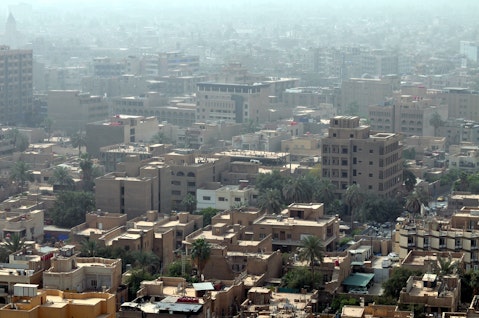In this article, we will take a look at the 30 most densely populated countries in the world in 2024. You can also check out the 20 Countries with the Largest Urban Population in the World.
According to a United Nations (UN) report, the global population is increasing rapidly. Having tripled in size over the past few decades, the global population is projected to reach 11 billion from the current 8 billion by the end of the century. This growth will predominantly occur in middle-class or low-income regions.
Key factors driving this growth include declining mortality rates in developing countries due to improved healthcare. Moreover, fertility rates in certain countries also contribute to overall growth. While the global fertility rate has dropped from 5 in 1960 to 2.4 in 2021, countries like Niger and Angola still have high fertility rates of 6.73 and 5.76, respectively.
You can check out the 30 Most Fertile Countries in the World Heading into 2024 here.
In underdeveloped countries, population growth can also be influenced by religious values. Some religions encourage large families to support their practices, leading to high birth rates within these communities. However, this growing population can strain global resources and agriculture. The increasing population drives a higher demand for food, with reports indicating that the agricultural sector needs to boost production by 70% by 2050 to meet these rising demands.
Industry Leaders Embracing Sustainable Practices
Looking at the negative impacts of high population density, some industry leaders are increasing their efforts to preserve the planet for future generations through sustainable practices. Popular companies supporting such practices include Microsoft Corporation (NASDAQ:MSFT), Apple Inc. (NASDAQ:AAPL), and PayPal Holdings, Inc. (NASDAQ:PYPL).
Microsoft Corporation (NASDAQ:MSFT), a leading technology company offering hardware, software, and cloud services, aims to become water-positive by 2030, meaning it will replenish more water than it uses. Moreover, the company plans to achieve zero waste in its direct operations and protect ecosystems by that year. In 2020, Microsoft Corporation (NASDAQ:MSFT) announced its sustainability goals, committing to be carbon-negative by 2030, which involves reducing more carbon emissions than it has produced since its founding in 1975.
Moreover, Apple Inc. (NASDAQ:AAPL), well known for its innovative products like the iPhone, is also committed to reducing carbon emissions. Recent reports indicate that Apple Inc. (NASDAQ:AAPL) has avoided 23 million metric tons of emissions so far, with a goal to become carbon neutral by 2030.
Similarly, PayPal Holdings, Inc. (NASDAQ:PYPL), the leading online payment platform, is taking steps to mitigate the environmental impacts of overpopulation by aiming for net-zero emissions by 2040. Furthermore, since 2021, PayPal Holdings, Inc. (NASDAQ:PYPL) has used 100% renewable energy for its global data centers.
Here’s what Wedgewood Partners said about PayPal Holdings, Inc. (NASDAQ:PYPL) in its Q1 2024 investor letter:
“PayPal Holdings, Inc. (NASDAQ:PYPL) has been a long-standing holding for Wedgewood, since 2015. After taking some of our gains around the company’s COVID-19-fueled peak in 2021, we have been adding to the stock slowly over the past two years, taking it back to a signi2icant position in the portfolio.
We would like to update you on our current thinking.
Like most “COVID-19 stocks”, a variety of companies (e.g., Amazon) benefited from artificially high growth rates due to the COVID-19 lockdowns and subsequent stimulus; fundamentals at PayPal saw a normalization as the world returned to normal through 2021- 2022. Similar to most of those companies, many PayPal investors had incorrectly assumed their artificially elevated growth rates during the COVID-19 period would continue for years and were surprised when the normalization occurred, leading to a decline in the Company’s admittedly overheated stock. The big difference between PayPal and many of these stocks (e.g., Amazon once again) is that PayPal still has not recovered from this broad normalization period…” (Click here to read the full text)

Frontpage/Shutterstock.com
Our Methodology
We used data from the United Nations (UN) to shortlist the 30 most densely populated countries in the world in 2024. The countries have been ranked in ascending order based on their population per square kilometer. It is important to note that we have excluded any islands or territories from our list.
At Insider Monkey, we are obsessed with the stocks that hedge funds pile into. The reason is simple: our research has shown that we can outperform the market by imitating the top stock picks of the best hedge funds. Our quarterly newsletter’s strategy selects 14 small-cap and large-cap stocks every quarter and has returned 275% since May 2014, beating its benchmark by 150 percentage points. (see more details here).
30 Most Densely Populated Countries in the World in 2024
30. Vietnam
Population per Square Kilometer: 317
Despite having one of the highest population densities in the world, Vietnam’s population is not evenly distributed. The heaviest clustering occurs along the South China Sea and Gulf of Tonkin. For the past several decades, Vietnam has seen both internal migration and net emigration driven by humanitarian and economic reasons.
29. Pakistan
Population per Square Kilometer: 318
With a population density of 318 people per square kilometer, Pakistan is one of the most densely populated countries in the world in 2024.
28. Japan
Population per Square Kilometer: 325
Between 1960 and 2022, Japan’s population experienced an increase from 93 million to over 125 million individuals, marking a growth of more than 34% over the span of 62 years. Currently, Japan has a population density of 325 people per square kilometer.
27. Sri Lanka
Population per Square Kilometer: 350
Sri Lanka is undergoing significant shifts in its population dynamics. There has been an unexpected rise in fertility rates, leading to changes in age demographics. The country’s fertility rate stands at 2.1 births per woman.
26. Grenada
Population per Square Kilometer: 373
Grenada has a population density of 373 people per square kilometer. The country recorded a 0.7% population growth in 2022.
25. Tuvalu
Population per Square Kilometer: 383
Tuvalu is one of the smallest countries, with a land area of just 92 km². Despite its small population, the country has a high population density. Most residents in Tuvalu are subsistence farmers.
24. Belgium
Population per Square Kilometer: 387
Belgium is a highly developed country with many job opportunities that attract immigrants. It is one of the most densely populated countries in Europe.
23. Philippines
Population per Square Kilometer: 397
The population of the Philippines represents approximately 1.46% of the global population.
22. Israel
Population per Square Kilometer: 430.2
With a population density of 430 people per square kilometer, Israel is in the 22nd position on our list of the most densely populated countries in the world in 2024.
21. Haiti
Population per Square Kilometer: 430.4
Haiti’s high fertility rate and a population growth rate of 1.24% as of 2022 have resulted in it being a densely populated country.
20. Comoros
Population per Square Kilometer: 466
Comoros is one of the poorest countries in Africa. In 2022, the birth rate in the country was recorded at 30.3 births per 1000 people.
19. India
Population per Square Kilometer: 485
India is one of the most populous countries in the world, with a population density of 485 people per square kilometer.
18. Lebanon
Population per Square Kilometer: 510
Lebanon has a high population density, with the majority residing in urban areas, especially Beirut.
17. South Korea
Population per Square Kilometer: 523
South Korea’s technological advancements and job opportunities significantly contribute to its high population density.
16. Burundi
Population per Square Kilometer: 524
Burundi is located in the eastern part of Africa. The country has a high population growth rate despite being one of the poorest countries.
15. Netherlands
Population per Square Kilometer: 525
Immigration, job opportunities, and strong social services have contributed to the Netherlands’ high population density.
14. San Marino
Population per Square Kilometer: 551
San Marino, with a land area of 61 km², has a population density of 551 people per square kilometer.
13. Aruba
Population per Square Kilometer: 590
Oranjestad is the most populous city in Aruba. The country is known for its beautiful beaches, which draw numerous tourists.
12. Rwanda
Population per Square Kilometer: 595
Rwanda has a fertility rate of 3.67 births per woman, contributing to its population growth. Rwanda will be among the top 15 most densely populated countries in the world in 2024.
11. Mauritius
Population per Square Kilometer: 641
High fertility rates, low mortality rates, and tourism contribute to Mauritius’ high population density. Mauritius is one of the most densely populated areas in the world.
10. Nauru
Population per Square Kilometer: 644
Nauru is known for its phosphate mining industry, which offers employment opportunities. Despite its small overall population, Nauru’s limited land area of 21 km² leads to a high population density.
9. Barbados
Population per Square Kilometer: 657
Barbados ranks as the ninth most densely populated country in the world, with a majority of its population concentrated in Bridgetown and its surrounding areas. The country is also widely popular among tourists due to its stunning beaches.
8. Bermuda
Population per Square Kilometer: 1,183
Bermuda has a landmass of only 53.2 square kilometers. It is among the top 10 most densely populated countries in the world in 2024.
7. Sint Maarten
Population per Square Kilometer: 1,303
Sint Maarten is renowned for its picturesque views, making it a popular tourist destination and attracting many residents seeking a peaceful life.
6. Bangladesh
Population per Square Kilometer: 1,342
Bangladesh is experiencing declining death rates and rapid development, leading to overpopulation. Urban migration is worsening this issue by putting strain on resources and infrastructure.
5. Malta
Population per Square Kilometer: 1,703
Malta is a small country. The country’s high living standards make it a popular choice among residents, particularly in central areas.





